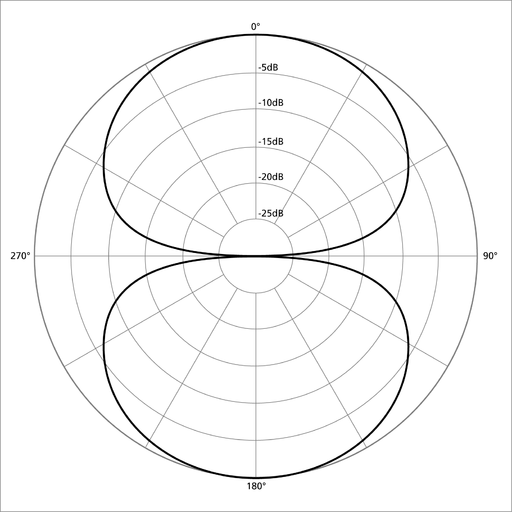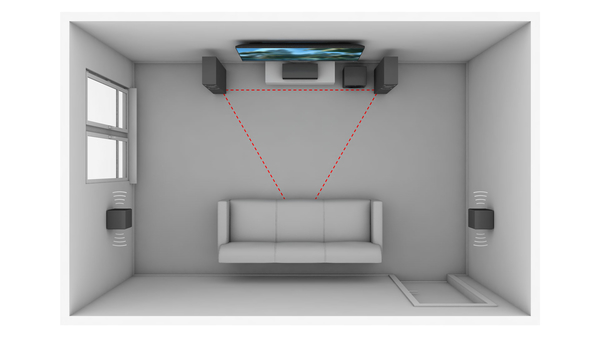
For explosions as well as birdsong: diffuse sound with the right dipole speaker set-up
What are directional speakers, dipole speakers and bipole speakers and where should they be placed to achieve the optimum sound
Some people are content with built-in TV speakers - others think those are the worst. The same applies to high-quality gaming systems. Anyone who has ever enjoyed high-quality surround sound knows how impressive diffuse sound can be - even at home. But what is the best way to achieve it? And depending on how familiar you are with the subject, you may now be asking yourself: diffuse, is that good at all?
In this article, we explain the different operation principles of directional speakers, dipole speakers and bipole speakers and give tips on how to set them up. You want to know straight away how to set up your dipole speakers at home? Click here to continue.
This is how directional speakers,
dipole speakers and bipole speakers work
Never fear: we will not start from scratch here and explain the basic functionality of speakers. You know how they work. We will do it differently: we will show you how directional speakers, bipole speakers and dipole speakers work and take the home cinema as an example. However,
Good sound is individual. There is no one-size-fits-all for really good sound.
Good sound depends firstly on your room and secondly on the type of speakers you have. The good news: great sound can be achieved in various ways. One thing that is always important is reflection.
- Most classic speaker systems are directional speakers. With a single tweeter, they distribute the sound within a specific radiation angle in one direction, forwards. Unless they are deliberately placed in the room, our ears can locate the audio signal from directional speakers very reliably. But many home cinema enthusiasts want to avoid exactly that. Therefore they choose dipole speakers. However, three-dimensionality is also possible with directional speakers, more on that later.
- Dipole speakers are often distinguished from directional speakers by the 'triangular' shape of the cabinet. Dipole speakers have two tweeters that emit the sound in two different directions, to the front and back or to the right and left, depending on how you look at it. This means that the sound does not reach the listeners directly, but via detours by reflection. The situation is similar for speakers with an open baffle. But what is more: dipole speakers work 'out of phase'. This means that the tweeters reproduce the signals asynchronously. The result is a large, clearly audible three-dimensionality. A special form of dipole speaker is the open baffle, such as our KATANA-M1.
A dipole speaker emits sound in two different directions.
Bipole speakers can hardly be distinguished visually from dipole speakers. They also have two tweeters that emit sound in two directions, albeit synchronously. Many dipole speakers can be switched to bipole mode. While this is suitable for music or gaming, special sound effects in films come across best in dipole mode. In other words, whenever we do not want to locate the audio source so precisely.
Dipole speaker set-up in cinemas:
a diffuse sound field from the side
Imagine yourself in a cinema hall: apart from the subwoofer, centre speakers and front speakers, which are indispensable for surround sound, there are many small dipole speakers on the walls to your right and left. These are the so-called effect speakers.
If you sit level with a dipole speaker, you are in a 'blind spot', so to speak.
The directivity of dipole speakers is not simply a forward-radiating cone, but a 'figure of eight' to the front and to the back. To the side (90°) you hear almost nothing. That is what we call 'cancellation'. The sound is distributed quite differently in the room via the many dipole speakers and is thrown back to you via various reflections. Directional speakers that are aimed exactly at you create less three-dimensionality.
The directivity of dipole speakers is not simply a forward-radiating cone, but a 'figure of eight' to the front and to the back. To the side (90°) you hear almost nothing. That is what we call 'cancellation'. The sound is distributed quite differently in the room via the many dipole speakers and is thrown back to you via various reflections. Directional speakers that are aimed exactly at you create less three-dimensionality.

Dipole speakers at home: positioning and height
Dipole speakers are particularly suitable in private living rooms if there is hardly any space between the sofa and the rear wall and it is therefore not possible to place speakers behind you. What is very important for dipole speakers, however, are side walls.
Dipole speakers are best mounted 20-60 cm above ear level on the side walls.
So, you install the dipole speakers to the right and left of you as wall speakers. They radiate to the front in the direction of the television and to the rear in the direction of the rear wall. Thus, no direct sound can be heard at the listening position. You are not directly exposed to the sound, but sit in a cloud of sound.
You will not have the impression that the sound is coming from the side walls. In fact, you cannot pinpoint the source. What sounds negative is exactly what many home cinema fans want.
By the way, if you do not have suitable side walls, but can only use the rear wall, it is best to attach the speakers to the right and left behind you on the rear wall. Try out whether you prefer the dipole or bipole operation of the speaker. And in which surround system you want to use them.
Surround sound in home cinemas: these systems are available
Only very few living rooms really provide perfect conditions for the best surround sound. That is because they are living rooms not cinema halls. Understandably, furniture is set up first and then speaker systems are added. It would be better to survey a 'bare' room and to take your time to decide on which side you want to set up the 'front'. This is where your front speakers and the TV would be placed and, of course, anything else you require. The crucial initial question is, which system do you want to use? We have a few examples:
Dolby stereo systems: two stereo speakers that you place to the left and right of the TV and turn towards you at a 60° angle.
Dolby 2.1: stereo speakers with subwoofer. If you want to include a subwoofer, you can do little wrong. The human ear can hardly locate very low frequencies. You can place it centrally or slightly offset between the two front speakers.
Dolby Surround 5.1: the classic home cinema consists of six speakers, i.e., centre speaker, subwoofer, two front speakers and two sideways mounted effect speakers (often dipole speakers).
Dolby Surround 7.1: additional power from the rear. The set-up of a 7.1 system is analogue to a 5.1 system. However, two additional effect speakers are added on the rear wall.
Dolby Atmos: the Dolby Atmos system provides additional sound from above. You can either mount Atmos speakers on the ceiling or you place so-called top speakers on the front speakers. Those top speakers are then directed towards the ceiling and work with reflection.
Diffuse sound is also possible with directional speakers
Diffuse sound is what fascinates us so much in films with lots of effects. We perceive the main action of the film mostly from the front, just as intended. But many background noises reach our ears from all sides. With directional speakers, this effect is generally more difficult to achieve.
In a home cinema with a surround system, directional speakers are most likely to be placed sideways behind the sofa in the space between the sofa and the wall. Of course, the spatial conditions must be suitable for this. You will be able to locate the audio source precisely. However, if this bothers you, you can use another little trick:
Aim the directional speakers at the ceiling and again it is the reflections that create a lot of spatiality.
You see, good sound is not easy to achieve, and, above all, it is not always the same. The home cinema is only one example. Audio quality always depends on room sizes, speaker types and many other factors. Feel free to browse through our magazine. We have many more interesting articles for you. Or, if you are reading this as a retailer, installer or planner, please contact us here if you want to realise a PA project.
Image sources Adobe Stock, innershadows, alexhitrov and ra2 studio





